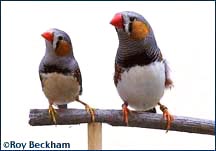Bravo!!!!! Well said!!!Myzomela wrote:A question for all the show breeders out there.
Why is the ideal bird for showing so large and why such a solid body shape?
These birds bear no resemblance to the true wild-type bird ( I'm not referring to colour mutations here).
Who decides that such an odd-shaped bird is the 'ideal'?
I'm just aware of all the problems seen in many show animals from this selective breeding- poor fertility, decreased disease resistance and shorter lifespans- just look at the show budgies.
I
The Timor zebra
- Tintola
- ...............................

- Posts: 1700
- Joined: 08 Mar 2011, 21:12
- Location: Murwillumbah1l
OH LORD, SAVE ME FROM YOUR FOLLOWERS!

- desertbirds
- ...............................

- Posts: 1318
- Joined: 21 Nov 2010, 09:13
- Location: Alice Springs
Hey Pete, im not quite getting your post.We only have a small pet shop here but they do stock Zebs and occasionally get birds in from Adelaide dealers.Almost all zebs ive seen in the shop are larger than our wild ones.Ive seen a few that literally dwarf our native guys.If the Timor ones are here how did they get here ? Did come of there own accord or were they introduced ? It just doesnt make sense that someone would bring them in as our native ones are so common here.poitta wrote:, but the wild caught ones from up north are much larger than we keep . . they were much bigger because they were from wild stock....
I thought too that prehaps the size difference and some very small,poorly coloured zebs around could be inbreeding.
- GregH
- ...............................

- Posts: 1671
- Joined: 17 Feb 2009, 08:20
- Location: Brisbane
- Location: Chapel Hill, Brisbane Qld
Some genomes seem to be more resistant to the deleterious effects of inbreeding than others. I guess with plants there are so many inbred lines that this assumption just isn’t applicable but to survive change there has to be a large number of adapted genotypes spread over a large area because like death and taxes nothing is more certain than change. In animals a narrow genetic base certainly presents problems. Deleterious dominant genes are eliminated immediately but with recessives you only get to see them in homozygotes and it takes a while to weed them out but once eliminated inbred-lines aren’t a problem. The real problem is that we humans aren’t as brutal or emotionless as mother nature and we let a proportion of these weak individuals survive when nature dictates they shouldn’t. If you read Mike Fidler’s article on how he changed from fostering to self-rearing you get to see how strong a stomach you have to have to fix things. Yes you will cull a lot of birds initially but in the end your lines will be stronger for it.
As for why “bigger is better” maybe it’s a boy thing? My wife is head of grain quality here at IRRI and she has this theory based on the staff of most cereal breeding institutes where the breeders are all men and they select for yield (size) and the quality evaluation staff are nearly all female and they want to know how good it is. In aviculture the show material is always selected for size but extremes of any nature seem to be tolerated if not actively selected for. A couple of years ago I saw a “feather duster” budgie at Ace Colony and I had to ask what species it was as it was so enormous and feathers so monstrous I didn’t even know what species it was. This affliction with the bizarre is not new just look at the poor gold-fish! I hope there is a strong move to more conservation-based aviculture. I read that the European stocks of the Red-Eared Parrotfinch (my Avitar) are all “infected” with BFPF as the breeders there tried to increase so now I can’t even import a native bird. Perhaps aviculture needs more female judges.
As for why “bigger is better” maybe it’s a boy thing? My wife is head of grain quality here at IRRI and she has this theory based on the staff of most cereal breeding institutes where the breeders are all men and they select for yield (size) and the quality evaluation staff are nearly all female and they want to know how good it is. In aviculture the show material is always selected for size but extremes of any nature seem to be tolerated if not actively selected for. A couple of years ago I saw a “feather duster” budgie at Ace Colony and I had to ask what species it was as it was so enormous and feathers so monstrous I didn’t even know what species it was. This affliction with the bizarre is not new just look at the poor gold-fish! I hope there is a strong move to more conservation-based aviculture. I read that the European stocks of the Red-Eared Parrotfinch (my Avitar) are all “infected” with BFPF as the breeders there tried to increase so now I can’t even import a native bird. Perhaps aviculture needs more female judges.
- GregH
- ...............................

- Posts: 1671
- Joined: 17 Feb 2009, 08:20
- Location: Brisbane
- Location: Chapel Hill, Brisbane Qld

Just found a good site to read up on the Timor Zebra. Roy Beckingham has a lot to say on his efinch site. Roy has some nice photos to show the difference and even some hybrids.
